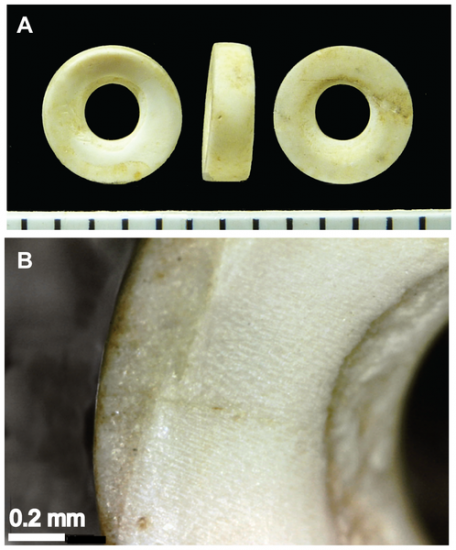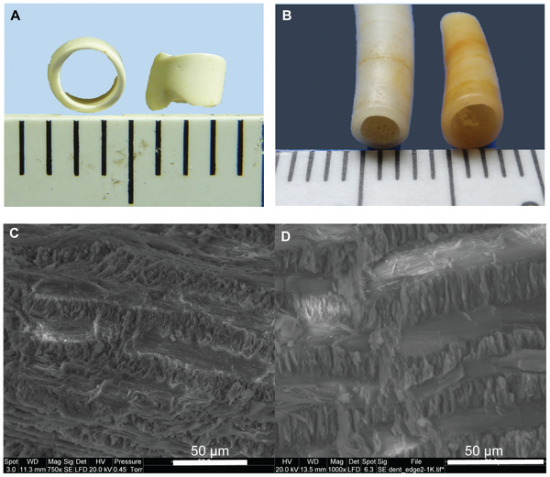University of York
Source - http://phys.org/news/2014-06-amino-acids-shells-bronze-age.html

Right- and left-handed shells from the collections of the UC Berkeley Natural History Museums. Credit: Nipam Patel/UC Berkeley
A new study by scientists at the University of York has shed new light on the use of mollusc shells as personal adornments by Bronze Age people.
The research team used amino acid racemisation analysis (a technique used previously mainly for dating artefacts), light microscopy, scanning electron microscopy and Raman spectroscopy, to identify the raw materials used to make beads in a complex necklace discovered at an Early Bronze Age burial site at Great Cornard in Suffolk, UK.
They discovered that Bronze Age craftspeople used species like dog whelk and tusk shells, both of which were likely to have been sourced and worked locally, to fashion tiny disc-shaped beads in the necklace. The research is published in PLOS ONE.

Great Cornard bead 3682. (a) Photograph and (b) photomicrograph of the surface. The bulk of the bead is granular but this surface has the remnants of a thin layer of a whiter, more opaque material with a finely striated appearance. doi:10.1371/journal.pone.0099839.g005
The researchers included archaeologists, mathematicians, chemists and physicists, the latter from the BioArCh and York Centre for Complex Systems Analysis (YCCSA) and the Departments of Archaeology, Mathematics, Chemistry and Physics at the University of York. Dr Sonia O'Connor, of the University of Bradford's Department of Archaeological Sciences, carried out the light and electron microscopy, and prehistoric jewellery specialist Dr Alison Sheridan, of National Museums Scotland, facilitated access to the Great Cornard necklace, which had been excavated by Suffolk Archaeology.
When it was first realised that the tiny white beads had been made from shell, the question arose as to its source. Had the shell been obtained locally or did it originate from a species from further afield, perhaps even the Mediterranean thorny oyster (Spondylus)? The Mediterranean thorny oyster is a shell of long-standing symbolic and cultural significance which is known to have been used on the Continent around the time when the Great Cornard necklace was made.
But this collaborative research, led by Dr Beatrice Demarchi, of York's Department of Archaeology and BioArCh, and Dr Julie Wilson, of the Departments of Chemistry and Mathematics and YCCSA, has shown this not to be the case, and has suggested an alternative possibility.

Great Cornard bead 3870 and Antalis sp. Photograph (a, b) and scanning electron microscopy images (c, d) of bead 3870 (a, c) and Antalissp. (b, d). doi:10.1371/journal.pone.0099839.g006
Dr Demarchi said: "Dog whelks and tusk shells were likely to be available locally so these people did not have to travel far to get hold of the raw materials for their beads. "There is evidence, from elsewhere in Britain and further afield, for the use of tusk shells at various times in the past. This may well be because they are relatively easy to work and their hollow shape is very distinctive."
Dr Wilson added: "The statistical analysis used pattern recognition algorithms for taxonomic identification, comparing the composition of the beads with a large database of shell amino acid compositions. Although we cannot know the origin of the beads for certain, our multidisciplinary approach provides additional evidence for the identifications."
More information: An Integrated Approach to the Taxonomic Identification of Prehistoric Shell Ornaments, PLOS ONE: dx.plos.org/10.1371/journal.pone.0099839